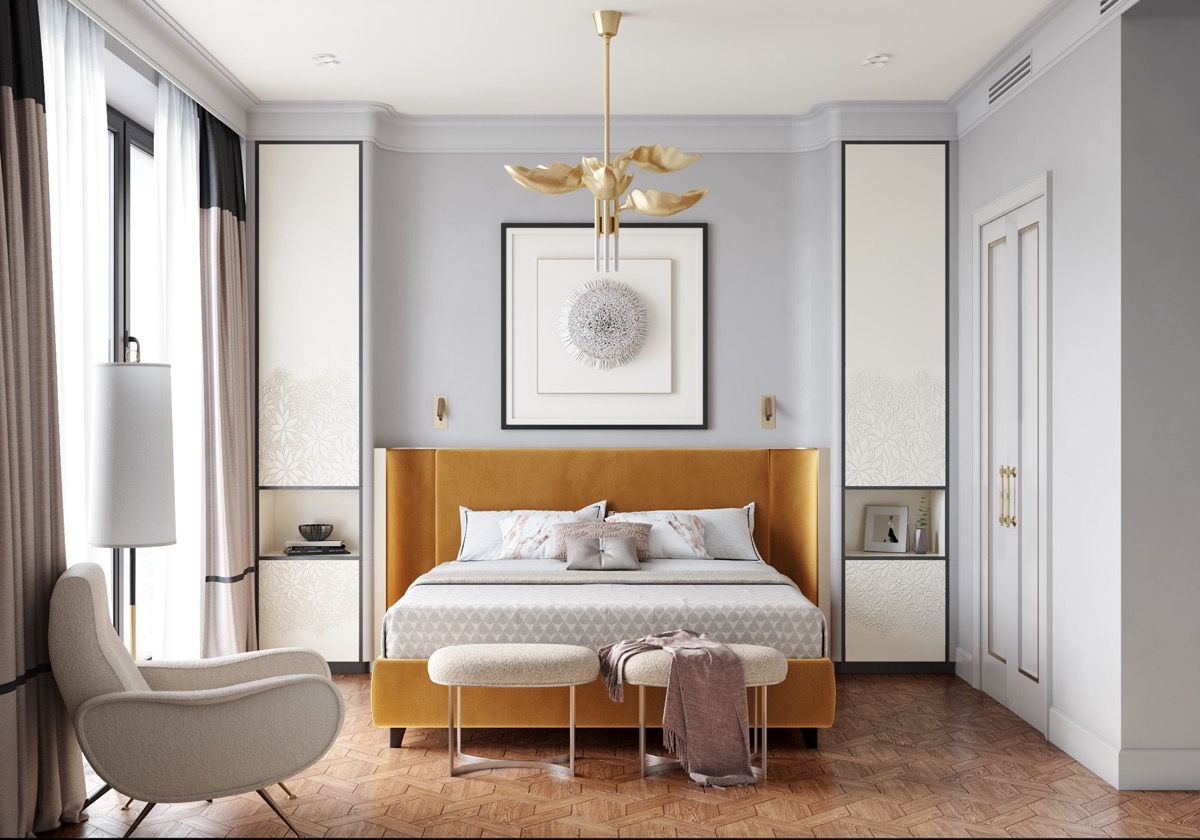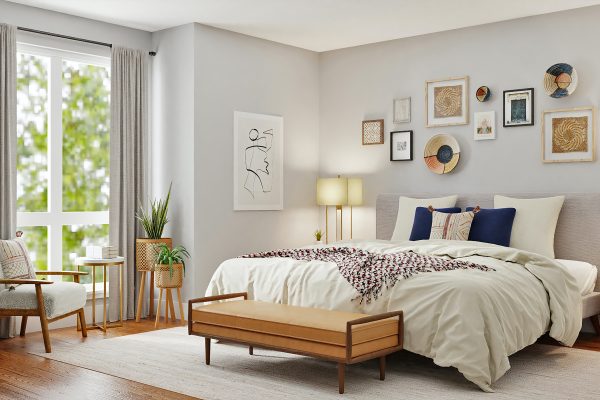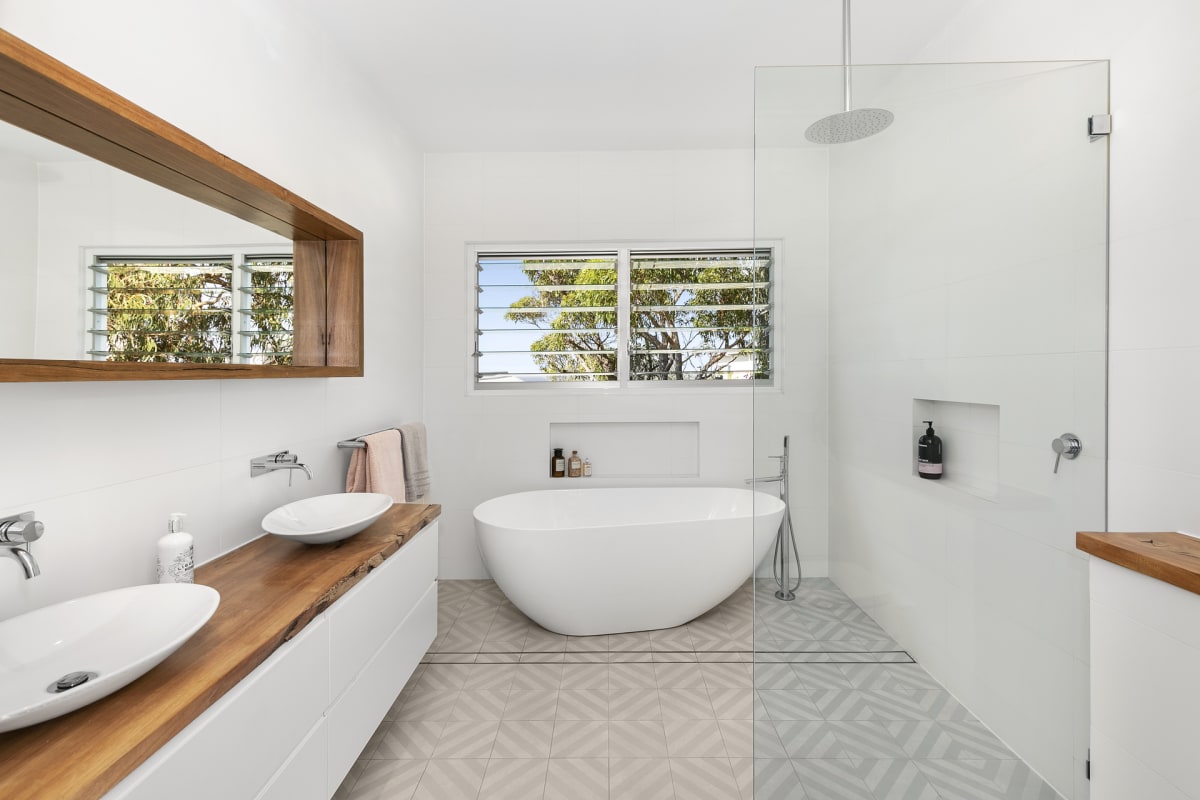Home>Interior Design>Bedroom Furniture Arranging Mistakes: 8 Layouts To Avoid


Interior Design
Bedroom Furniture Arranging Mistakes: 8 Layouts To Avoid
Modified: October 20, 2024
Avoid these 8 common bedroom furniture arranging mistakes with our interior design tips and discover the best layouts for a well-designed bedroom space.
(Many of the links in this article redirect to a specific reviewed product. Your purchase of these products through affiliate links helps to generate commission for Storables.com, at no extra cost. Learn more)
Introduction
Designing a bedroom that not only looks beautiful but also functions well can be a challenging task. One of the key elements in creating a well-designed bedroom is arranging the furniture in the right way. The way you arrange your bedroom furniture can greatly affect the overall look and feel of the space.
In this article, we will explore some common mistakes people make when arranging their bedroom furniture and provide you with eight different layouts to avoid. By understanding these mistakes and learning how to correct them, you can transform your bedroom into a comfortable and aesthetically pleasing sanctuary.
Whether you are starting from scratch or looking to revamp your current bedroom furniture arrangement, this guide will help you make informed decisions that will optimize both the functionality and beauty of your space.
So, let’s dive into the world of bedroom furniture arranging and learn about the common mistakes to avoid!
Key Takeaways:
- Avoid placing the bed against the wall to create a visually appealing and flexible layout. Consider the flow of movement and balance of furniture to promote relaxation and comfort in your bedroom.
- Integrate the TV into the overall bedroom design and maximize natural light by avoiding furniture placement in front of windows. Incorporate adequate storage solutions to create a peaceful and orderly environment.
Mistake 1: Placing the Bed Against the Wall
One of the most common mistakes people make when arranging their bedroom furniture is placing the bed directly against the wall. While this may seem like the obvious choice to save space, it can actually make the room feel cramped and unbalanced.
By positioning the bed against the wall, you limit your options for other furniture placement and create an awkward layout. Instead, try pulling the bed away from the wall and create a focal point in the room. This will give you more flexibility to arrange additional furniture and create a more visually appealing space.
If your bedroom is small and you’re concerned about space, you can still create a functional layout by placing the bed at an angle in the corner of the room. This helps to create a cozy and inviting atmosphere while maximizing the available space.
Another mistake to avoid is placing the headboard directly against a window. While it may seem like a good idea to utilize the available space, it can disrupt the natural flow of light and create an uncomfortable sleeping environment. Instead, consider placing the bed on a different wall or using a low-profile headboard that doesn’t block the window.
By avoiding the mistake of placing the bed against the wall, you can create a well-balanced and visually appealing bedroom layout that promotes relaxation and comfort.
Mistake 2: Neglecting the Flow of Movement
When arranging bedroom furniture, it’s important to consider the flow of movement within the space. Neglecting this aspect can lead to a cluttered and inefficient layout that hinders your ability to navigate the room comfortably.
One common mistake is placing furniture in a way that obstructs the natural pathways in the room. For example, if you have to constantly maneuver around a large dresser or bedside table to get to the other side of the room, it can disrupt the flow and make the space feel cramped.
To avoid this mistake, consider creating clear pathways between furniture pieces. This means leaving enough space to comfortably walk and move around the room. Take into account the size of your furniture and the layout of the room when determining the best arrangement.
Another consideration is the location of doors and windows. Ensure that your furniture placement doesn’t block or hinder the functionality of these elements. For example, don’t place a dresser in front of a closet door or a chair in front of a window, as it can impede access and natural light flow.
By paying attention to the flow of movement in your bedroom, you can create a more spacious and functional layout. This will not only enhance the overall design of the room but also improve your daily experience and ease of navigation.
Mistake 3: Ignoring the Balance of Furniture
Creating a balanced furniture arrangement is crucial when it comes to bedroom design. Ignoring this aspect can result in a visually unappealing and disjointed look. Achieving balance involves considering the size, shape, and placement of furniture in relation to each other.
One mistake to avoid is having all the large furniture pieces on one side of the room while leaving the other side empty. This can create an imbalance and make the room feel lopsided. Instead, distribute the weight of furniture evenly throughout the space to create a visually pleasing arrangement.
Another common mistake is placing all the tall or heavy furniture on one wall, while leaving the opposite wall empty or with only small items like artwork or a mirror. This can create an unbalanced visual effect. Instead, try to distribute taller furniture pieces across different walls to create harmony and balance in the room.
Consider the scale of your furniture as well. If you have a large bed with an oversized headboard, make sure to balance it with other appropriately-sized furniture pieces, such as bedside tables or a chest of drawers. This will help create a cohesive and well-proportioned look.
Lastly, don’t forget about visual balance. If you have a bold-colored or patterned piece of furniture, balance it with more neutral and understated pieces. This will create a sense of harmony and prevent the room from feeling overwhelming.
By paying attention to the balance of furniture in your bedroom, you can create a visually appealing and harmonious space that promotes relaxation and comfort.
Mistake 4: Overcrowding the Room with Too Much Furniture
When it comes to bedroom design, less is often more. One of the most common mistakes people make is overcrowding the room with too much furniture. This can make the space feel cramped, cluttered, and overwhelming.
Avoid the temptation to fill every corner of the room with furniture. Instead, focus on selecting key pieces that are necessary for functionality and comfort. Consider the size of your bedroom and prioritize the essentials such as a bed, bedside tables, and a dresser. This will ensure that you have enough space to move around and create a visually appealing layout.
Another mistake to avoid is having oversized or bulky furniture in a small bedroom. This can make the room feel claustrophobic and limit your ability to move freely. Instead, opt for furniture that is appropriately scaled to the size of the room. Choose pieces with a streamlined design and compact dimensions to maximize space and create a more open feel.
Additionally, be mindful of the placement of furniture in relation to each other. Leave enough space between items to promote a sense of openness and airiness. This will create a more comfortable and visually pleasing atmosphere.
Remember, a well-designed bedroom should be a sanctuary for relaxation and rest. By avoiding the mistake of overcrowding the room with too much furniture, you can create a spacious and inviting space that promotes a sense of calm and tranquility.
When arranging bedroom furniture, avoid placing the bed directly in line with the door, as it can create a feeling of unease. Instead, position the bed diagonally or against a wall for better flow and energy in the room.
Read more: Furniture Arranging Mistakes
Mistake 5: Placing the TV as the Focal Point
In today’s digital age, it’s common to have a TV in the bedroom for entertainment purposes. However, making the TV the focal point of the room can detract from the overall design and disrupt the intended ambiance of a bedroom.
Many people make the mistake of placing the TV on the center wall, directly across from the bed. While this may seem convenient for viewing, it can overpower the space and shift the focus away from the intended purpose of relaxation and sleep.
Instead, consider incorporating the TV into the overall bedroom layout in a more subtle and balanced way. One option is to mount the TV on the wall or place it on a console or stand that complements the surrounding furniture. This allows the TV to blend into the room rather than dominate it.
Another approach is to create a dedicated media wall where the TV is surrounded by artwork, shelves, or a gallery wall. This helps to integrate the TV into the overall design scheme and prevent it from becoming the sole focus of the room.
Additionally, consider the viewing angles and ergonomics when positioning the TV. Ensure that it can be comfortably viewed from the bed without straining the neck or eyes.
Remember, the bedroom should be a space for rest and relaxation. By avoiding the mistake of making the TV the focal point, you can create a more peaceful and visually balanced atmosphere that promotes a restful sleep environment.
Mistake 6: Improperly Positioning the Bedside Tables
Bedside tables are not only functional pieces of furniture, but they also serve as visual accents in the bedroom. Improperly positioning them can throw off the balance of the room and make the overall design feel awkward.
One common mistake is placing bedside tables that are too large or too small for the size of the room or the bed. Oversized bedside tables can overwhelm a smaller bedroom, while tiny tables can look out of place in a larger space. It’s important to choose bedside tables that are proportionate to both the bed and the size of the room to create a harmonious and visually pleasing arrangement.
Consider the height of the bedside tables in relation to the height of the bed. Ideally, the tables should be about the same height or slightly lower than the top of the mattress. This allows for easy access to items on the table while lying down and maintains a balanced visual effect.
Another mistake to avoid is positioning the bedside tables too close to the bed. While it may seem logical to have them within arm’s reach, this can make the space feel cramped and claustrophobic. Instead, leave enough space between the bed and the tables to create a more open and spacious feel.
Placement is also important when it comes to the symmetry and visual balance of the room. If you have a larger bed, consider placing a bedside table on each side for a symmetrical look. This creates a cohesive and well-balanced design that is pleasing to the eye.
By properly positioning your bedside tables, you can create a functional and visually appealing layout that enhances the overall design of your bedroom.
Mistake 7: Blocking Natural Light with Furniture Placement
Natural light is a valuable asset in any bedroom, as it not only brightens up the space but also creates a sense of openness and connection to the outdoors. Unfortunately, one common mistake people make when arranging their furniture is blocking or obstructing natural light sources, such as windows or skylights.
Placing furniture in front of windows or covering them with heavy curtains can prevent natural light from entering the room. This can not only make the space feel darker and gloomier but also limit the benefits of natural light, such as improved mood and overall well-being.
To avoid this mistake, consider the placement of your furniture in relation to the windows. Opt for smaller and more lightweight pieces that can be placed against walls or away from the window area. This allows natural light to flow freely into the room and creates a more vibrant and inviting ambiance.
If you have larger pieces of furniture that need to be placed near a window, such as a bed or a dresser, try to position them in a way that allows light to pass through. For example, you could choose a bed frame with a low or open headboard, or use semi-sheer curtains that allow light to filter through while still maintaining privacy.
Additionally, consider the layout of your room and how it can maximize natural light. If possible, arrange furniture in a way that directs the flow of light throughout the space. This can be achieved by placing mirrors strategically to reflect light or choosing light-colored furniture and accessories that help to brighten the room.
By avoiding the mistake of blocking natural light with furniture placement, you can create a bedroom that is filled with warmth, brightness, and a connection to the outdoors.
Mistake 8: Lack of Storage Solutions
A bedroom should not only be a visually appealing space but also a functional one. One common mistake people make when arranging their bedroom furniture is neglecting to incorporate adequate storage solutions. This can result in a cluttered and chaotic environment that detracts from the overall aesthetic and creates a sense of disorganization.
Lack of storage space can lead to clothes piled up on chairs, books scattered on the floor, and various items taking up valuable surface space. To avoid this mistake, it’s important to consider your storage needs and incorporate appropriate solutions into your bedroom design.
One way to add storage is by utilizing the space underneath the bed. Opt for a bed frame with built-in drawers or invest in bed risers that elevate the bed, creating additional storage space underneath. This is a practical solution for keeping extra linens, blankets, and out-of-season clothing neatly tucked away.
Another area to address is the closet. If your bedroom has a closet, make sure to maximize its potential by using organizers, such as hanging rods, shelves, and shoe racks. This will help you keep your clothes and accessories organized and easily accessible.
If your bedroom lacks a closet or sufficient storage space, consider incorporating additional furniture pieces with built-in storage. Dressers, chests, and wardrobes can provide ample space for storing clothing, accessories, and other personal belongings.
Don’t forget about vertical storage options as well. Install floating shelves or wall-mounted cabinets to take advantage of vertical space and keep items off the floor. This not only adds functionality but also adds visual interest to the room.
By addressing the lack of storage solutions, you can create a more organized and clutter-free bedroom. This allows for a peaceful and relaxing environment where everything has its designated place, promoting a sense of serenity and order.
Read more: How To Arrange Furniture In Bedroom
Conclusion
Arranging bedroom furniture is a crucial aspect of creating a well-designed and functional space. By avoiding common mistakes and considering key factors such as balance, flow, and functionality, you can transform your bedroom into a sanctuary that promotes relaxation, comfort, and visual appeal.
One of the primary mistakes to avoid is placing the bed against the wall. By pulling the bed away from the wall and creating a focal point, you can achieve a more visually appealing and flexible layout. Additionally, be mindful of the flow of movement and ensure there are clear pathways throughout the room to create a sense of spaciousness.
Ignoring the balance of furniture can throw off the overall harmony of the room. Be sure to distribute the weight of furniture evenly and select appropriately-sized pieces that complement the scale of your bedroom. Remember to pay attention to visual balance as well, balancing bold or statement pieces with more neutral elements.
Overcrowding the room with too much furniture can make the space feel cramped and cluttered. Focus on the essentials and prioritize functionality and comfort over excessive decoration. By leaving enough space between furniture pieces, you can create a more open and breathable environment.
While a TV can be a popular addition to the bedroom, make sure it doesn’t become the sole focal point. Integrate the TV into the overall design and consider alternative placement options to maintain balance in the room. By keeping the TV subtle, you can preserve the intended ambiance of relaxation and sleep.
Pay attention to the positioning of bedside tables, ensuring they are proportionate to the size of the room and the bed. Keep them at an appropriate height and leave enough space for easy movement. Properly positioned bedside tables contribute to a functional and visually cohesive bedroom layout.
Blocking natural light with furniture placement can hinder the brightness and openness of the space. Maximize natural light by avoiding furniture placement in front of windows and incorporating lighter curtains or blinds. This will not only enhance the visual appeal of the room but also improve the overall mood and well-being.
Lastly, don’t overlook the importance of storage solutions. Lack of storage can lead to a cluttered environment, so incorporate appropriate options such as under-bed storage, closet organizers, and vertical storage solutions. By keeping your belongings organized and out of sight, you can create a peaceful and orderly bedroom.
In conclusion, through careful consideration of furniture arrangement, you can transform your bedroom into a well-designed, functional, and visually appealing space. By avoiding these common mistakes and applying the principles discussed, you can create a bedroom that promotes relaxation, comfort, and a sense of harmony. So start planning and arranging your bedroom furniture with these tips in mind, and enjoy the benefits of a well-designed and beautiful space.
Frequently Asked Questions about Bedroom Furniture Arranging Mistakes: 8 Layouts To Avoid
Was this page helpful?
At Storables.com, we guarantee accurate and reliable information. Our content, validated by Expert Board Contributors, is crafted following stringent Editorial Policies. We're committed to providing you with well-researched, expert-backed insights for all your informational needs.














0 thoughts on “Bedroom Furniture Arranging Mistakes: 8 Layouts To Avoid”